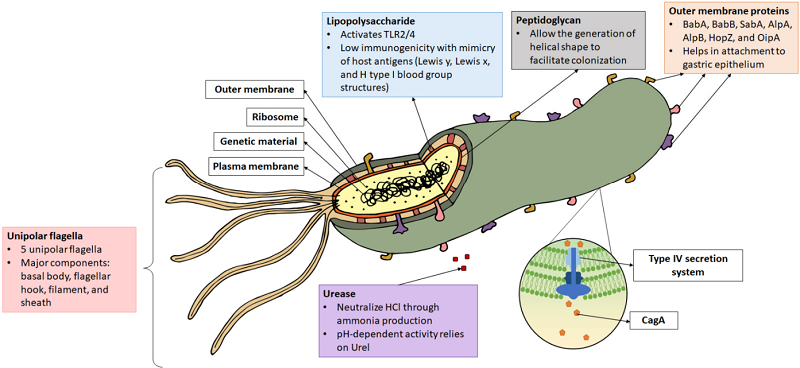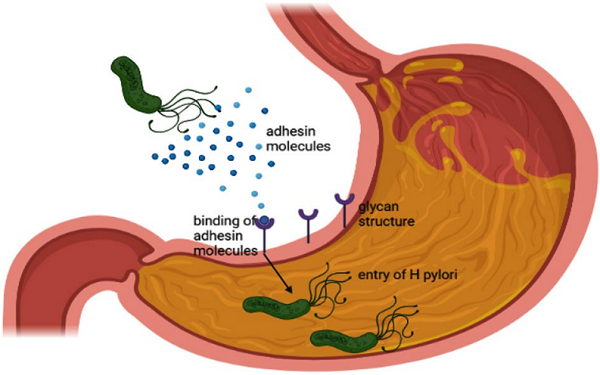IVDs (in vitro diagnostics) are convenient diagnostic tools that have been widely used for the diagnosis and prognosis of diseases, as well as for monitoring drug therapies. Recently, Creative Biolabs has launched a series of biomarker-specific IVD antibody development services to make your IVD project a success. Our scientists specialized in IVD antibody development are pleased to assist you in your projects in a timely and cost-effective way.
About Helicobacter pylori
Helicobacter pylori (H. pylori), which is previously called Campylobacter pylori, is a helix-shaped, gram-negative, microaerophilic bacterium about 3μm long with a diameter of about 0.5μm. H. pylori consists of a large diversity of strains and is commonly found in the stomach. H. pylori is able to form biofilms and convert from spiral to a possibly viable but nonculturable coccoid form. It has four to six flagella at the same spot, and the distinctive sheathed flagellar filaments of H. pylori consist of two copolymerized flagellins, known as FlaA and FlaB. H. pylori requires oxygen at a lower concentration than in the atmosphere. A hydrogenase of H. pylori can generate energy via oxidizing molecular hydrogen (H2) produced by intestinal bacteria, and H. pylori then produces catalase, oxidase, and urease. The outer membrane of H. pylori is composed of phospholipids and lipopolysaccharide (LPS), and also contains cholesterol glucosides found in few other bacteria.
 Fig.1 Structure of Helicobacter pylori.1
Fig.1 Structure of Helicobacter pylori.1
H. pylori in Gastrointestinal Disease
H. pylori is associated with chronic gastritis, gastric ulcers and the development of duodenal ulcers and stomach cancer. However, over 80% of individuals infected with the H. pylori are asymptomatic, and it may play a crucial role in the natural stomach ecology. H. pylori impairs the stomach and duodenal linings via several mechanisms. The ammonia produced by H. pylori to regulate pH is considered to be toxic to epithelial cells, as are other biochemicals produced by H. pylori including proteases, certain phospholipases, and vacuolating cytotoxin A (VacA). And VacA can not only damage the epithelial cell but also disrupt tight junctions and lead to apoptosis. Besides, cytotoxin-associated gene called CagA, could also cause inflammation and is a potential carcinogen. H. pylori colonization of the stomach can cause chronic gastritis, an inflammation of the stomach lining. Helicobacter cysteine-rich proteins (Hcp), particularly HcpA, are supposed to trigger the immune response, causing inflammation. What’s more, H. pylori infection is regarded as a strong risk factor for certain types of stomach cancer.
 Fig.2 Pathophysiology of Helicobacter pylori with the stomach lining.2
Fig.2 Pathophysiology of Helicobacter pylori with the stomach lining.2
H. pylori Antibody Development Services
Stool antigen test, blood test, and urea breath test are commonly used to diagnose H. pylori infections. To meet this end, scientists at Creative Biolabs can help you develop novel antibodies for the detection of H. pylori. Besides, Creative Biolabs also provides one-stop diagnostic immunoassay development services, including feasibility analysis, assay design, assay protocol establishment, validation, and production. Please feel free to contact us for more details.
References
- Cheok, Yi Ying, et al. "An overview of Helicobacter pylori survival tactics in the hostile human stomach environment." Microorganisms 9.12 (2021): 2502. Distributed under Open Access license CC BY 4.0, without modification.
- Lenka, Sudhansubala, and Ruchi Bhuyan. "Management of H. pylori induced pepticulcer—a phytotherapeutic approach." J Pure Appl Microbiol 16.3 (2022): 1530-1537. Distributed under Open Access license CC BY 4.0, without modification.
For Research Use Only.

